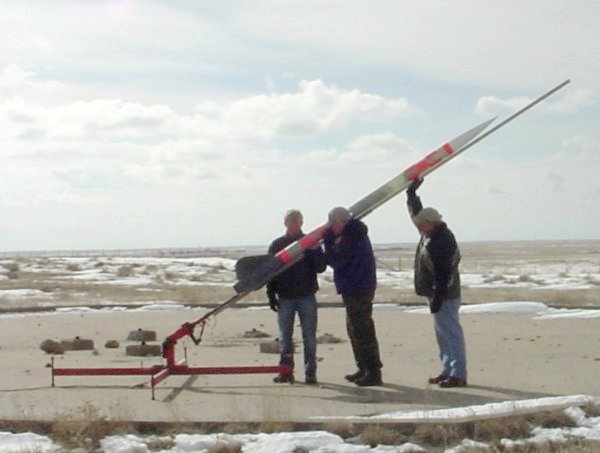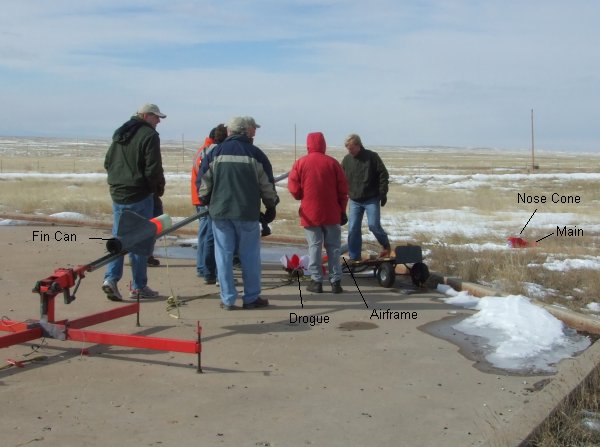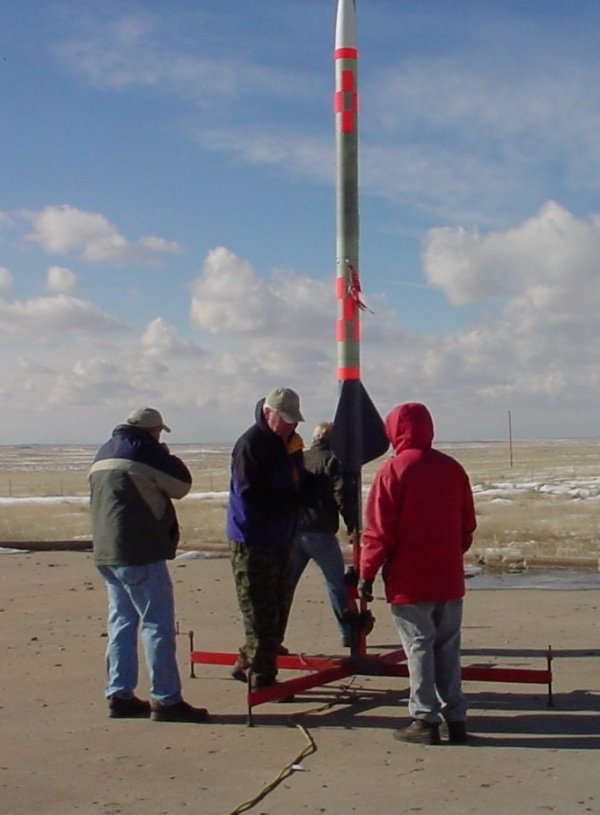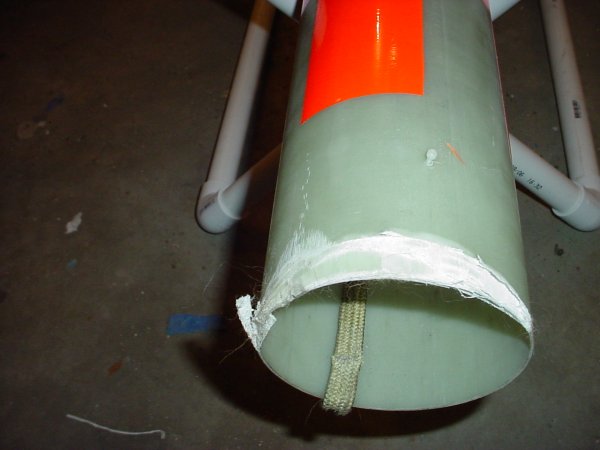Forums › Archives › Archives 2006-2010 › L3 Countdown
- This topic has 77 replies, 15 voices, and was last updated 17 years, 7 months ago by
slipstick.
-
AuthorPosts
-
February 1, 2008 at 8:06 pm #40123
slipstick
Being unable to continue my monthly asymptotic progression through the HP cert process because the available waiver limitations, I plan on flying my L3 cert rocket Slipstick III on Saturday Feb 2 with a K560W just for fun. It should be a good shakedown flight for this bird and will provide another test of the GPS/TX tracking/recovery technique.

If you would like to look at the steps on what it took to build it, (provided for the benifit of my TAPs), you can review them on http://www.telerover.com There are over 400 pictures documenting the build. Each photo has imbedded text to explain what I am doing.
Fortunately, all the parts and materials arrived just in time for the 3 day MLK weekend, which allowed the stellar build rate.
I’d like to thank Bruce Schaefer and Joe Hinton for taking the time to come over and assist me with the Ground Test last Saturday. The above picture of the weigh-in was taken just before the test, by Joe.
A side note, I’m plagued with back problems and I pinched a nerve in my back trying to convert the rocket factory back into a garage so I could get the truck in before the snow last wed, so If anyone has the bandwidth to help carry/retrieve Slipstick III (35# loaded) I’d appreciate it. Bruce has volunteered to help within his capacity. With an assist, I’ll fly Slipstick II (my L2 rocket), as well. Tim Thomas is bringing a J350W for that 9# missile.
February 1, 2008 at 8:33 pm #46723Jeremiah Johnson
I’ll be at the launch – I can retrieve heavy stuff.
Impressive rocket. Impressive build rate.
February 1, 2008 at 9:37 pm #46724slipstick
Super! Another rocket buddy! Thanks
February 1, 2008 at 11:34 pm #46725Bruce R. Schaefer
Mike, I’m going tomorrow just to assist you, plus I need the exercise. 😉
February 2, 2008 at 3:12 am #46726Art Hoag
ParticipantI have a flight lesson tomorrow morning out of Greeley from 8:00 to 10:00, as soon as I get on the ground I will be out.
Mike, when do you think you will fly Slipstick III?
Art
February 2, 2008 at 5:33 am #46727Conway Stevens
ParticipantWell unfortunately I have to at work so wont be able to make it… Good luck with the flights Mike.
February 3, 2008 at 9:43 pm #46728slipstick
ABORT ABORT ABORT
The following photos are at the Northern Colorado Rocketry Atlas site near Ault, CO on Feb 2, 2007. The intended launch was subverted by a previously unflown, brand new, but seemingly defective backup altimeter.
The altimeter seemed to have passed all the intial setup tests and responded correctly to the programming of the set points. However, after the altimeters were powered on and the shunts removed from the charges, we had a premature deployment of the backup charges. This occured about 15-20 seconds after enabling the charges, while we were trying to listen for the optimal 3 beeps from each altimeter. The drogue deployment went off first, while I had my ear to the avbay, with John Nelson supporting the rail. Fortunately the fin can section stayed on while the rest of the rocket left the rail followed immediately by the backup main charge being deployed (since we were obviously below 1000 feet elevation). Both chutes came out clean, an otherwise great deployment, not often seen this close by the spectators.
The picture seconds before everything came apart on us:

…and right after:

We figured that maybe we had triggered the sensors by lowering the launch rails down while the altimeters were armed, so I went ahead and prepared additional charges, and reassembled the rocket for another try. We tested the avbay with the charges armed outside the rocket for over 30 seconds and the backup altimeter and charges seemed to be behaving properly. Once the rocket was back on the pad, I powered the altimeters on, and once we were getting the correct number of beeps (the shunts give the same beeps as the charges in this mode) we connected up the ignitor to the K560W. I enabled the charges and stepped away from the pad. While we were standing fairly close by getting ready to check the continuity of the ignition system, The backup drogue charge went off again, followed by the main. Again the tail section stayed on the pad. I think the nose cone got to 30 foot elevation, the avbay and the rest of the airframe landing hard on the cement pad of the Atlas site. Wind speed was about 10mph in both instance, and the primary charges remained intact the whole time. I’m very thankful we had a slight delay in actually launching it, because if this rocket had separated during the thrust phase, instead of on the pad, it would have been destroyed.
Here we are, leaving it vertical this time, but to no avail:

Back at home, I cleaned the black powder residue off the interior of the airframe, cut 1″ off the middle airframe section and 2 inches of the forward airframe (nose cone) section. I will be returning the altimeter back to the manufacturer, and doing another attempt at shakedown flight on March 1st. THEN, maybe I’ll paint it.
Here’s part of the damage from falling on the concrete:

I’d like to thank Art, Bruce, John N., Tim, Joe, and all the other NCR members who helped get the pad setup and to help me get the rocket prepped (Both times).
February 3, 2008 at 10:52 pm #46729Bruce R. Schaefer
On the first attempt, Art and Mike had their heads to the avbay, John rested the rail on his shouder. I was taking the pictures; had I been any good at it, I would’ve gotten the charges going off. THEN BAM-BAM! What happened to Mike has always been one of my fears. Mike, you’re one of the most persistant rocket guys I know! It’s definitely an altimeter problem, which you’ll work out with the manufacturer privately. I have a vested interest in that, as I had planned to use one on a rocket similar to yours. Great pictures; now we all know what concrete does to PR G10, in close up. You’re lucky the nosecone shot off with no damage. Concrete and FG nosecones don’t work well with each other either. As we all agreed yesterday, you’ll have no trouble pushing your chutes out! Yesterday wasn’t what we’d hoped, but a good lesson for all of us.
February 3, 2008 at 11:17 pm #46730 MikeSModerator
MikeSModeratorIf I may ask?
Who’s altimeter?
All the above scares me also. One of My MHM birds will have
an altimeter and timer. Every thing has been tested and
worked in the past.I have read in a couple publications…. To. Very on and off
a few times and let the temp. equalize.
No one in person that uses them has ever confirmed the
verying on and off. Just the temp.
The publication said that by turning on, let stand, turn off
a few times will give a more accurate pressure reading. At the
launch site.If a person was to come up from 1000′ to a 5400′ launch site,
the altimeter could still be reading 1000′ as start. And the other
way around.Seemed reasonable. I have not been doing electronics long.
input from others would be nice.Thanks for sharing Your problems.
February 4, 2008 at 1:00 am #46731 Warren B. MusselmanModerator
Warren B. MusselmanModeratorI’m very sorry for your unexpected malfunction. I’d also like to know who’s altimeter and which model caused the problem. Doesn’t look too bad, slice off a couple inches and have at it again. Better luck next time Mike. Again, all my sympathies – the same, if not worse, has happened to many of us.
Letting the entire bird temp stablize prior to flight – perhaps even an hour or more, might be a very good idea. Thing with electronics is they tend to be even more temp sensitive. Barometric sensors used in altimeters are essentially strain guages on a piece of foil sealing an absolute pressure chamber (usually a near vacuum of known low pressure and about a cubic millemeter in volume, trending towards smaller volumes.) These are resistive bridge circuits (Wheatstone Bridge) and are typically vapor deposited materials – the very method implies temperature sensitivity. However, the idea that a commercial altimeter would fail in that way boggles. I hate to pick on altimeter manufacturers, but one would think that testing in the temperature range one would encounter in the real world – say 0 degrees F up through 125 degrees F, would be de rigeur.
One final thing I would note. If you had a Missileworks RRC2 or RRC2X and you installed the battery with reverse polarity, exactly the same result occurs – the charges go off shortly after enabling the altimeter. The newer RRC2X mini has a zener diode across each output that prevents this issue. Jon Skuba did this accidentally at an MHM with a very substantial charge and was lucky he didn’t get worse than a ringing in the ears. I did it once when assembling my 38mm altitude bird in my basement and had nearly 2 grams go off within 2′ of my head. Quite invigorating I should say…
Warren
-
AuthorPosts
- The forum ‘Archives 2006-2010’ is closed to new topics and replies.






